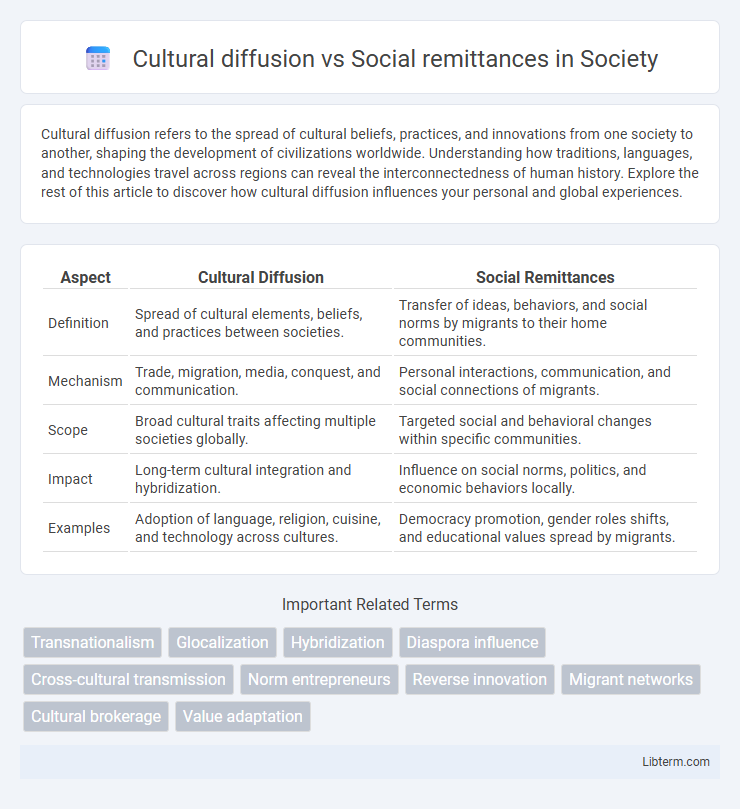Cultural diffusion refers to the spread of cultural beliefs, practices, and innovations from one society to another, shaping the development of civilizations worldwide. Understanding how traditions, languages, and technologies travel across regions can reveal the interconnectedness of human history. Explore the rest of this article to discover how cultural diffusion influences your personal and global experiences.
Table of Comparison
| Aspect | Cultural Diffusion | Social Remittances |
|---|---|---|
| Definition | Spread of cultural elements, beliefs, and practices between societies. | Transfer of ideas, behaviors, and social norms by migrants to their home communities. |
| Mechanism | Trade, migration, media, conquest, and communication. | Personal interactions, communication, and social connections of migrants. |
| Scope | Broad cultural traits affecting multiple societies globally. | Targeted social and behavioral changes within specific communities. |
| Impact | Long-term cultural integration and hybridization. | Influence on social norms, politics, and economic behaviors locally. |
| Examples | Adoption of language, religion, cuisine, and technology across cultures. | Democracy promotion, gender roles shifts, and educational values spread by migrants. |
Introduction to Cultural Diffusion and Social Remittances
Cultural diffusion refers to the spread of cultural beliefs, practices, and innovations from one society to another, shaping societal norms and identities across regions. Social remittances involve the transfer of ideas, behaviors, and social capital through migrants, influencing home communities' social structures and development. Both phenomena highlight the dynamic exchange of cultural elements beyond physical goods, impacting globalization and social change.
Defining Cultural Diffusion: Concepts and Examples
Cultural diffusion refers to the spread of cultural elements such as beliefs, technologies, languages, and customs from one society or group to another, often through trade, migration, or communication. Examples include the adoption of the alphabet from Phoenician traders by ancient civilizations, the global spread of fast food culture originating from the United States, and the integration of Buddhist practices into East Asian societies. This process plays a vital role in increasing cultural diversity and fostering intercultural exchange worldwide.
Understanding Social Remittances: Origins and Mechanisms
Social remittances originate from migrants transferring ideas, norms, behaviors, and social practices back to their home communities, influencing local social structures and cultural identities. These mechanisms operate through continuous interactions, such as communication, visits, and participation in transnational networks, facilitating the exchange of non-material cultural elements. Unlike cultural diffusion which broadly involves the spread of cultural traits across societies, social remittances specifically emphasize the bidirectional flow of social change driven by migration experiences.
Key Differences Between Cultural Diffusion and Social Remittances
Cultural diffusion involves the widespread spread of cultural beliefs, practices, and artifacts from one society to another, often occurring naturally over time through trade, migration, or communication. Social remittances refer to the transfer of ideas, norms, social practices, and behaviors from migrants back to their home communities, typically influencing social change and development. The key difference lies in cultural diffusion being a broad, often involuntary process affecting entire societies, while social remittances are intentional, individual or community-driven exchanges primarily linked to migration contexts.
Drivers and Agents of Cultural Diffusion
Cultural diffusion is driven by migration, trade, media, and technology, with agents such as immigrants, travelers, traders, and digital platforms facilitating the spread of cultural traits across regions. Social remittances, on the other hand, involve the transfer of ideas, practices, and social norms from migrants to their home communities, making migrants and transnational networks the primary agents. Both processes rely heavily on interpersonal communication and mobility but differ in their focus: cultural diffusion spreads broad cultural elements, whereas social remittances concentrate on socio-cultural changes influenced by migration patterns.
Channels and Impacts of Social Remittances
Social remittances flow primarily through interpersonal communication channels such as family ties, friendships, and community networks, facilitating the transfer of ideas, behaviors, and social norms from migrants to their home countries. These exchanges impact social structures by promoting changes in gender roles, education values, political participation, and cultural practices. Unlike cultural diffusion, which spreads cultural traits broadly and passively, social remittances involve purposeful, bidirectional communication that can transform social identities and reshape community development.
The Role of Migration in Cultural Exchange
Migration acts as a critical conduit for cultural diffusion, facilitating the spread of languages, customs, and traditions across borders. Social remittances, which encompass the transfer of ideas, norms, and social practices from migrants to their communities of origin, play a pivotal role in reshaping local cultural landscapes. Through these processes, migration not only disseminates cultural traits globally but also transforms societies by integrating diverse cultural influences.
Measuring the Influence: Cultural Diffusion vs Social Remittances
Measuring the influence of cultural diffusion involves analyzing the spread of cultural traits, ideas, and practices across societies over time using ethnographic studies and historical data. Social remittances are quantified through surveys and interviews that assess changes in social norms, behaviors, and values transmitted by migrants to their home communities. Comparing these metrics highlights how cultural diffusion manifests broadly across populations, while social remittances focus on the direct transfer of social capital within transnational networks.
Case Studies Demonstrating Both Processes
Case studies from Mexican migrant communities in the United States illustrate cultural diffusion through the adoption of American food habits and entertainment, while social remittances are evident in the transmission of political ideas and social norms back to Mexican hometowns. In South Asia, the exchange of traditional festival practices and crafts signifies cultural diffusion, whereas changes in gender roles and family structures due to overseas migration demonstrate social remittances. These examples highlight how migration acts as a conduit for both tangible cultural traits and intangible social changes across borders.
Implications for Globalization and Social Change
Cultural diffusion accelerates globalization by spreading ideas, technologies, and practices across borders, fostering interconnectedness and cultural hybridization. Social remittances, consisting of values, norms, and social capital transferred by migrants, deeply influence social change by reshaping identities and power dynamics within home communities. Both processes drive complex transformations in global societies, blending traditional frameworks with new global influences.
Cultural diffusion Infographic

 libterm.com
libterm.com